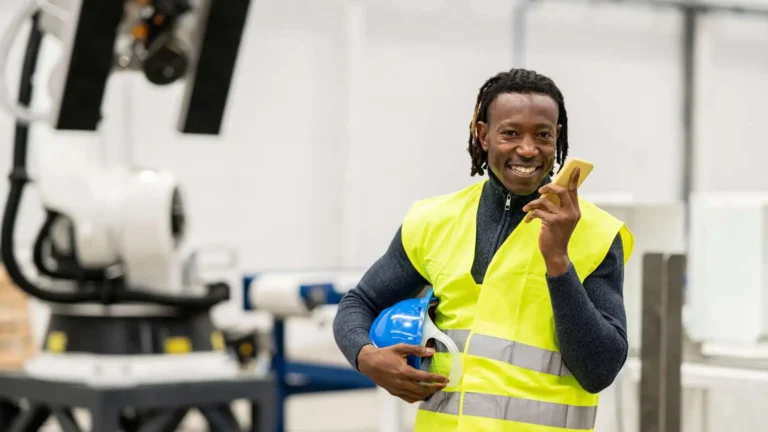Table of Contents
Production associates play a key role in keeping manufacturing operations running smoothly, and for those looking to grow, there are clear paths forward. If you’re a production associate aiming to take the next step, understanding how to train for line leader is a great place to start. This transition isn’t just about doing your job well—it’s about developing leadership skills, learning how to support your team, and gaining a deeper understanding of the production process.
Line leaders are the bridge between team members and supervisors, ensuring that goals are met and operations stay on track. By focusing on communication, time management, and problem-solving, production associates can build the foundation to lead confidently. Whether you’re stepping up to take more responsibility or want to prepare for future opportunities, learning how to train for line leaders is a smart move toward career advancement.
The Importance of Upskilling for Production Associates
This blog will guide you through the essential steps to upskill for a Line Leader position. We’ll cover the skills and certifications you need to advance, strategies for standing out in your role, and how Beem can help provide financial support during your training. Whether it’s paying for specialized training programs or helping you manage the costs of career advancement, Everdraft™ is here to assist you as you transition into a leadership position on the production line.
Understanding the Role of a Production Associate and Line Leader
What a Production Associate Does
As a Production Associate, your primary duties often involve operating machinery, assembling components, monitoring production quality, and ensuring the manufacturing process runs smoothly. Your role is essential for the day-to-day production of goods in many industries, including automotive, electronics, and food processing.
Responsibilities of a Line Leader
A Line Leader oversees a team of production associates, ensuring that production targets are met, quality standards are maintained, and safety protocols are followed. While a production associate may be focused on individual tasks, the line leader coordinates all activities on the line, manages time schedules, and solves problems that arise during production.
The jump from a production associate to a line leader involves taking on greater responsibilities, such as:
- Team work: Managing the production team involves ensuring that each member works efficiently and that the team meets the production goals.
- Quality control: Overseeing product quality and adjusting the production process as needed.
- Training new associates: As a line leader, you’ll help onboard and train new production associates, ensuring they meet company standards.
- Problem-solving: Handling any issues on the production line, whether a machine malfunction or a quality control problem.
As you can see, becoming a Line Leader means stepping up your responsibilities and preparing to handle the managerial and operational aspects of the production process.
Read related blog: CNA: How to Grow Your Skills for Healthcare Advancement
Key Skills and Certifications to Transition from Production Associate to Line Leader
1. Leadership Skills
Leadership is the most important skill you’ll need to develop as you transition to a line leader role. As a production associate, you may already lead by example, but as a leader, you must manage and guide a team.
Conflict Resolution
As a line leader, you will encounter conflicts among team members. Whether it’s personality clashes, misunderstandings, or production issues, you must know how to handle these situations calmly and efficiently. Conflict resolution training or workshops can prepare you for these scenarios.
Team Motivation
A key part of leadership is motivating your team, especially when production gets challenging or deadlines approach. Ensuring that everyone stays motivated and focused is essential for maintaining productivity.
2. Quality Control Expertise
Supervisors are responsible for overseeing the quality of the production process. This means you must develop expertise in quality control processes and procedures. Understanding how to maintain high standards of quality will help ensure that the end products meet customer and company expectations.
Quality Audits
A team leader may conduct periodic quality audits to ensure the production line meets the required standards. Training in quality auditing can help you learn how to assess the production process and identify areas for improvement.
Root Cause Analysis
When a quality issue arises, you are often tasked with identifying the root cause and fixing the problem. Learning root cause analysis techniques can help you identify issues early on and prevent them from affecting production.
3. Technical Skills
Understanding the machinery and equipment used on the production line is crucial. You’ll need to be able to troubleshoot issues, set up machines, and understand the production process inside and out.
Equipment Troubleshooting
As a supervisor, you may need to step in and assist when machines malfunction. Hands-on experience in equipment maintenance and troubleshooting will be key to your success.
Lean Manufacturing
Many manufacturing environments use lean manufacturing principles to reduce waste and improve efficiency. Familiarity with these principles will allow you to manage the production line better and increase overall productivity.
4. Communication Skills
As a line leader, you will communicate constantly with your team, upper management, and other departments. Strong communication skills will help ensure everyone is on the same page and that issues are addressed quickly.
Briefings and Reporting
You will lead team briefings, discuss production goals, and provide regular progress reports. Effective communication in these situations will make you a more effective team leader.
Team Coordination
Coordinating between different departments (e.g., supply chain, quality control, and production) is a crucial part of the role. Your communication skills will ensure that everyone is working toward the same goal.
Read related blog: How to Upskill When You’re Busy With Work & Family
Certifications and Training Programs for Advancing to Line Leader
1. Leadership and Supervisory Training
Enrolling in leadership development programs will give you the skills to lead a team effectively. These programs often focus on team management, conflict resolution, decision-making, and strategic thinking.
2. Quality Control Certifications
Many organizations offer certifications in quality control and quality management systems. These certifications can increase your knowledge and credibility, making you more competitive for line leader positions. Look for certifications such as ISO 9001 or Six Sigma.
3. Technical and Equipment Training
You must be familiar with the equipment to manage the production line effectively. Technical courses related to the machinery specific to your industry can be highly beneficial. Many companies offer in-house training programs, or you can enroll in external technical certifications.
4. Lean Manufacturing Certification
Certification in lean manufacturing principles, such as Six Sigma or Kaizen, can be advantageous for advancing to line leader positions. These certifications demonstrate your ability to increase productivity and reduce waste on the production floor.
How Beem’s Everdraft™ Can Support Your Training Journey
Educational Expenses
Upskilling to become a line leader often requires time and money. Training programs, certifications, and educational courses may have associated costs, including tuition, books, and exam fees. Beem’s Everdraft™ provides instant cash advances of up to $1,000 without interest, credit checks, or income restrictions. Whether you’re covering educational expenses or managing other financial obligations, Everdraft™ provides the financial flexibility to help you stay on track as you advance your career.
No Need for Loans or Debt
Rather than taking out a loan or using high-interest credit to cover your training expenses, Beem’s Everdraft™ offers a short-term financial solution that is easy to access and pay back. This lets you focus on your career development without worrying about immediate financial pressure.
Behavioral Insights: Staying Motivated During Career Advancement
1. Setting Achievable Milestones
Career advancement is a marathon, not a sprint. You can maintain a sense of accomplishment by setting achievable goals and milestones. For example, aim to complete a certification within a specific timeframe and break the process into smaller tasks like completing individual modules or attending training sessions.
2. Tracking progress
Tracking your progress is a great way to stay motivated. Use a journal or an app to track certifications completed, courses taken, and new skills learned. Seeing how far you’ve come will encourage you to keep moving forward.
3. Building a Support Network
Advancing your career can be challenging, so having a support system is important. Find mentors, join study groups, or connect with other professionals in your field. Sharing your journey with others helps you stay engaged and motivated.
Read related blog: Admin Assistant? Here’s How to Become Office Manager
Overcoming Common Roadblocks to Career Advancement
Lack of Experience
You may lack the experience needed for a line leader role. If so, consider gaining experience in leadership by taking on small projects or mentoring new hires. You can also seek opportunities to lead teams during training exercises or internal company events.
Financial Constraints
Training and certifications can be expensive. Beem’s Everdraft™ allows you to access short-term funds to cover your educational costs and get the necessary training without worrying about how to finance it.
Balancing Work and Study
Many production associates find it challenging to balance work and study. Consider taking evening classes, online courses, or part-time training programs to allow flexibility in your schedule. Staying organized and setting aside time for study is key to success.
Take the First Step Toward Becoming a Line Leader
Advancing from a production associate to a line leader requires dedication, time, and skills. Gaining leadership, technical, and quality control expertise allows you to position yourself for greater responsibility and career growth. Remember, Beem’s Everdraft™ is here to help you finance your education, certifications, and other expenses related to your career advancement. Download the app now.
Take charge of your future today, and start working toward becoming a line leader in the production industry.
FAQs on Advancing to Line Leader Roles
How long does transitioning from a production associate to a line leader take?
The timeline varies depending on your current skills, experience, and the certifications you need. On average, it can take one to two years to upskill, gain certifications, and move into a line leader role.
What certifications do I need to become a line leader?
Key certifications include leadership training, lean manufacturing, and quality control certifications. These will help you develop the technical and managerial skills needed.
How can Beem’s Everdraft™ help me fund my career advancement?
Everdraft™ provides instant cash advances of up to $1,000, which can be used to cover the costs of certifications, training programs, and exam fees. Thus, you can focus on your education without financial stress.
What other responsibilities does a line leader have compared to a production associate?
A line leader supervises the production team, manages production goals, ensures quality control, and is responsible for solving problems that arise on the production line.
Can I advance to a line leader role without formal education?
Yes, experience and hands-on training can take you far. However, gaining leadership, quality control and lean manufacturing certifications will improve your chances of securing a line leader position.















































